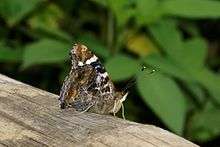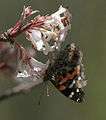Vanessa indica
| Indian Red Admiral | |
|---|---|
 | |
| Scientific classification | |
| Kingdom: | Animalia |
| Phylum: | Arthropoda |
| Class: | Insecta |
| Order: | Lepidoptera |
| Family: | Nymphalidae |
| Tribe: | Nymphalini |
| Genus: | Vanessa |
| Subgenus: | Cynthia |
| Species: | V. indica |
| Binomial name | |
| Vanessa indica (Herbst, 1794) | |
| Synonyms | |
|
Vanessa calliroe (Hübner, 1808) | |
Vanessa indica, called the the Indian Red Admiral globally, except in the in the United States where it is called the Asian Admiral, is a butterfly found in the higher altitude regions of India, primarily the Himalayas and the Nilgiri Hills. It is a close relative of the Painted Lady.
Description

Resembles Vanessa cardui but the ground colour is darker both on the upper and under sides, and the orange markings deeper and richer in tint. Differs also as follows: Underside forewing: the ochraceous orange-red on disc, and across cell proportionately of less extent, and uniform, not getting paler towards apex of cell; the upper four spots of the prcapical transverse series on the black apical area minute. it is about 5 inches in length. Hindwing: the postdiscal transverse band much narrower and shorter, not extending below vein 1, margined inwardly by a series of broad black subcrescentic marks; the tornal angle with a small patch of violet scales bordered inwardly by a short black transverse line. Underside very much darker than in V. cardui, the orange-red on disc and in cell on forewing restricted as on the upperside; three small transversely placed blue spots beyond the cell. Hindwing: the mottling comparatively very dark, purplish blade, with slender white margins, shaded on disc with rich dark olive-brown; the postdiscal series of ocelli dark and somewhat obscure; an inner subtei-minal transverse series of blue, and an outer very much slenderer transverse series of black lunules. Cilia of both forewings and hindwings white, alternated with brown. Antenna black, tipped with pale ochraceous; head, thorax and abdomen with dark olive-brown pubescence; beneath, the palpi, thorax and abdomen pale ochraceous brown.[1]
The Vanessa indica is not reported as a pest on any crop but on ramie it is causing considerable damage by feeding on young tender leaves which affect the growth of the plant. The larvae of this insect pest feed on tender young leaves as shown in the picture. The adults lay the eggs on tender leaves in which larvae emerge and feeds on young tender leaves preferably at neck region of the leaves, due to this leaves look likes the hanging like position and latter get dry. The caterpillar feeds on young leaves and latter fold the leaves in such a way that both the margins get attached by silky web and pupation takes place inside the folded leaf. Latter the adult emerge as a beautiful Indian butterfly. The specimen of this insect pest was sent to NPIB, New Delhi for identification and determined it as Lepedopteron insect from family Nymphalidae of species Venessa indica Herbst. registered under RRS No. 3199-3202/11.This insect pest occurrence is a germplasm specific and infestation was found more on R- 67-34 (kanai) germplasm.
Range
V. indica is found in the higher altitude regions (above 2,000 feet (610 m))[1] of India including the Nilgiri Hills in southern India. It also occurs on smaller hill ranges in Peninsular India such as the Nandi hills near Bangalore.
Larva
The larvae of V. indica are known to feed on:
- Urtica (nettles)
- Urtica thunbergiana
- Girardinia heterophylla (Himalayan nettle)
- Boehmeria densiflora
- Boehmeria nivea (Ramie)
Cultural references
- In March 1987 DPR Korea issued a postage stamp depicting Vanessa indica.
References
- 1 2 Bingham, C.T. (1905). The Fauna of British India, Including Ceylon and Burma Butterflies. 1 (1st ed.). London: Taylor and Francis, Ltd..
External links
| Wikimedia Commons has media related to Vanessa indica. |
- http://www.funet.fi/pub/sci/bio/life/insecta/lepidoptera/ditrysia/papilionoidea/nymphalidae/nymphalinae/vanessa/
- Kunte, K. 2010. Vanessa indica Herbst, 1794 – Indian Red Admiral. In, K. Kunte, U. Kodandaramaiah & Kalesh S. (eds.). Butterflies of India. v.1.0. accessed on 28 February 2010.
Gallery

 In Kullu district, Himachal Pradesh, India (around 11,500 feet (3,500 m))
In Kullu district, Himachal Pradesh, India (around 11,500 feet (3,500 m)) In Kullu district, Himachal Pradesh, India (around 7,500 feet (2,300 m))
In Kullu district, Himachal Pradesh, India (around 7,500 feet (2,300 m))_at_Samsing%2C_Duars%2C_West_Bengal_W_IMG_6369.jpg)